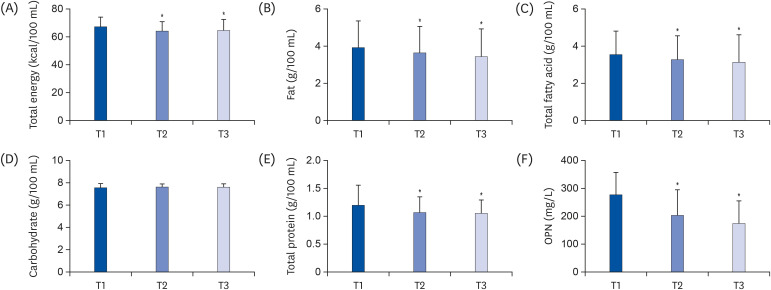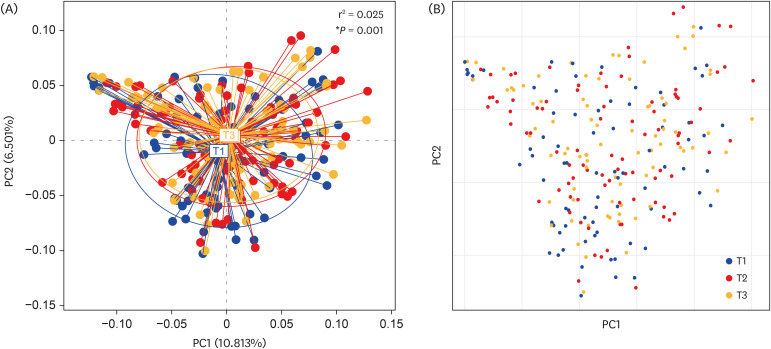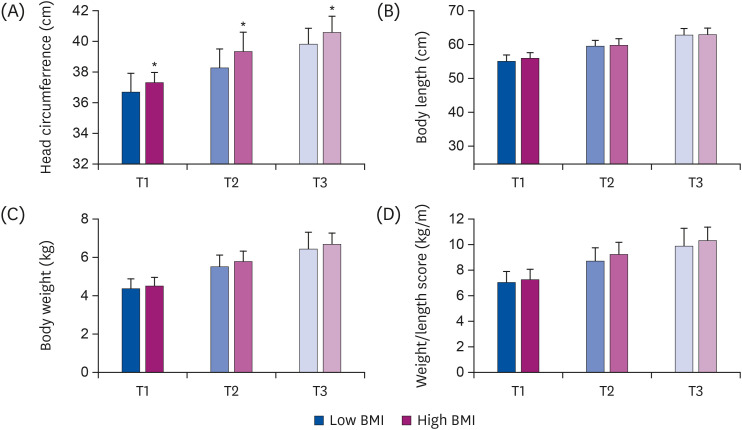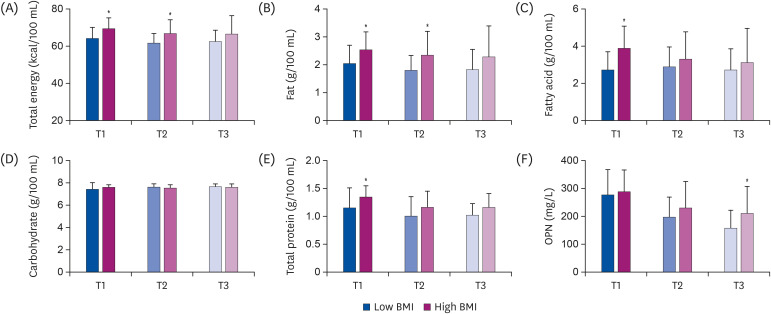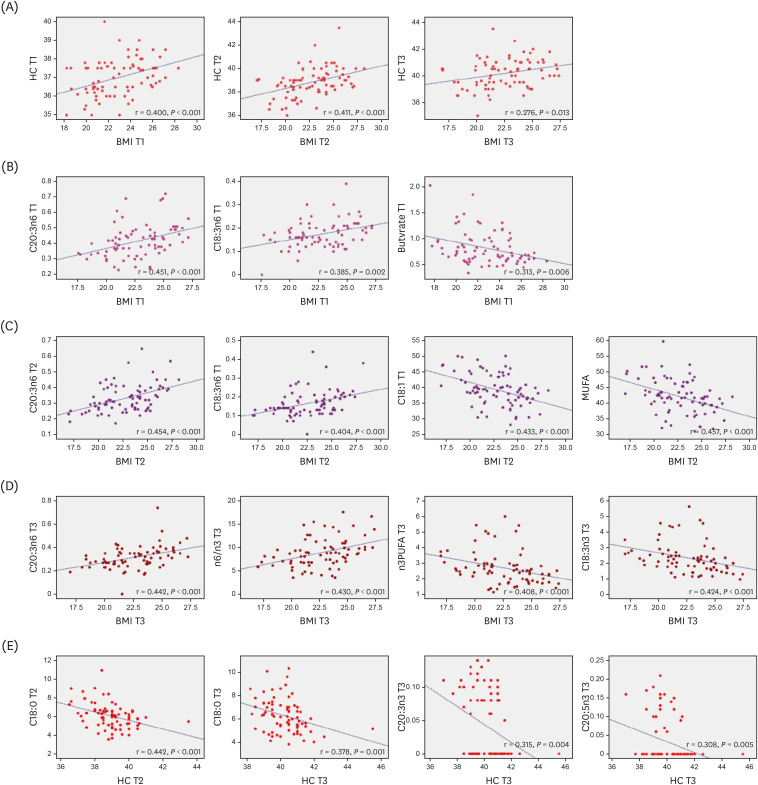Nutr Res Pract.
2021 Jun;15(3):367-381. 10.4162/nrp.2021.15.3.367.
Xiang Study: an association of breastmilk composition with maternal body mass index and infant growth during the first 3 month of life
- Affiliations
-
- 1H&H Group, Global Research and Technology Center, Guangzhou 510700, China
- 2School of Food Science, South China Agricultural University, Guangzhou 510642, China
- 3Division of Laboratory Medicine, Zhujiang Hospital, Southern Medical University, Guangzhou 510280, China
- 4Child Health Care Center, Changsha Hospital for Maternal and Child Care, Changsha 410007, China
- 5H&H Group, Global Research and Technology Center, Cork, P61 C996, Ireland
- KMID: 2516075
- DOI: http://doi.org/10.4162/nrp.2021.15.3.367
Abstract
- BACKGROUND/OBJECTIVES
This study aimed to establish a mother and child cohort in the Chinese population, and investigate human breastmilk (HBM) composition and its relationship with maternal body mass index (BMI) and infant growth during the first 3 mon of life.
SUBJECTS/METHODS
A total of 101 Chinese mother and infant pairs were included in this prospective cohort. Alterations in the milk macronutrients of Chinese mothers at 1 mon (T1), 2 mon (T2), and 3 mon (T3) lactation were analyzed. HBM fatty acid (FA) profiles were measured by gas chromatography (GC), and HBM proteomic profiling was achieved by matrix-assisted laser desorption/ionization time-of-flight (MALDI-TOF) mass spectrometry (MS).
RESULTS
During the first 3 mon of lactation (P < 0.05), significant decreases were determined in the levels of total energy, fat, protein, and osteopontin (OPN), as well as ratios of long-chain saturated FA (including C16:0, C22:0 and C24:0), monounsaturated FA (including C16:1), and n-6 poly unsaturated FA (PUFA) (including C20:3n-6 and C20:4n-6, and n-6/n-3). Conversely, butyrate, C6:0 and n-3 PUFA C18:3n-3 (α-linolenic acid, ALA) were significantly increased during the first 3 mon (P < 0.05). HBM proteomic analyses distinguished compositional protein differences over time (P = 0.001). Personalized motherinfant analyses demonstrated that HBM from high BMI mothers presented increased total energy, fat, protein and OPN, and increased content of n-6 PUFA (including C18:3n-6, C20:3n-6 and n-6/n-3 ratio) as compared with low BMI mothers (P < 0.05). Furthermore, BMI of the mothers positively correlated with the head circumference (HC) of infants as well as the specific n-6 PUFA C20:3n-6 over the 3 time points examined. Infant HC was negatively associated with C18:0.
CONCLUSION
This study provides additional evidence to the Chinese HBM database, and further knowledge of FA function. It also helps to establish future maternal strategies that support the healthy growth and development of Chinese infants.
Keyword
Figure
Reference
-
1. Lanigan J, Singhal A. Early nutrition and long-term health: a practical approach. Proc Nutr Soc. 2009; 68:422–429. PMID: 19698202.
Article2. Ziegler EE. Growth of breast-fed and formula-fed infants. Nestle Nutr Workshop Ser Pediatr Program. 2006; 58:51–59. discussion 59–63.
Article3. Ong KK, Emmett P, Northstone K, Golding J, Rogers I, Ness AR, Wells JC, Dunger DB. Infancy weight gain predicts childhood body fat and age at menarche in girls. J Clin Endocrinol Metab. 2009; 94:1527–1532. PMID: 19240149.
Article4. Belkind-Gerson J, Carreón-Rodríguez A, Contreras-Ochoa CO, Estrada-Mondaca S, Parra-Cabrera MS. Fatty acids and neurodevelopment. J Pediatr Gastroenterol Nutr. 2008; 47 Suppl 1:S7–S9. PMID: 18667917.
Article5. Martin CR, Ling PR, Blackburn GL. Review of infant feeding: key features of breast milk and infant formula. Nutrients. 2016; 8:279.
Article6. Prentice P, Acerini CL, Eleftheriou A, Hughes IA, Ong KK, Dunger DB. Cohort profile: the Cambridge Baby Growth Study (CBGS). Int J Epidemiol. 2016; 45:35.a–g. PMID: 26721600.
Article7. Verbeke KA, Boobis AR, Chiodini A, Edwards CA, Franck A, Kleerebezem M, Nauta A, Raes J, van Tol EA, Tuohy KM. Towards microbial fermentation metabolites as markers for health benefits of prebiotics. Nutr Res Rev. 2015; 28:42–66. PMID: 26156216.
Article8. Gao Z, Yin J, Zhang J, Ward RE, Martin RJ, Lefevre M, Cefalu WT, Ye J. Butyrate improves insulin sensitivity and increases energy expenditure in mice. Diabetes. 2009; 58:1509–1517. PMID: 19366864.
Article9. Fujimori M, França EL, Fiorin V, Morais TC, Honorio-França AC, de Abreu LC. Changes in the biochemical and immunological components of serum and colostrum of overweight and obese mothers. BMC Pregnancy Childbirth. 2015; 15:166. PMID: 26264971.
Article10. Collado MC, Laitinen K, Salminen S, Isolauri E. Maternal weight and excessive weight gain during pregnancy modify the immunomodulatory potential of breast milk. Pediatr Res. 2012; 72:77–85. PMID: 22453296.
Article11. Kim H, Kang S, Jung BM, Yi H, Jung JA, Chang N. Breast milk fatty acid composition and fatty acid intake of lactating mothers in South Korea. Br J Nutr. 2017; 117:556–561. PMID: 28285609.
Article12. Heinig MJ, Nommsen LA, Peerson JM, Lonnerdal B, Dewey KG. Energy and protein intakes of breast-fed and formula-fed infants during the first year of life and their association with growth velocity: the DARLING Study. Am J Clin Nutr. 1993; 58:152–161. PMID: 8338041.
Article13. Butte NF, Garza C, Johnson CA, Smith EO, Nichols BL. Longitudinal changes in milk composition of mothers delivering preterm and term infants. Early Hum Dev. 1984; 9:153–162. PMID: 6714135.
Article14. Ferris AM, Dotts MA, Clark RM, Ezrin M, Jensen RG. Macronutrients in human milk at 2, 12, and 16 weeks postpartum. J Am Diet Assoc. 1988; 88:694–697. PMID: 3372922.
Article15. Neville MC, Allen JC, Archer PC, Casey CE, Seacat J, Keller RP, Lutes V, Rasbach J, Neifert M. Studies in human lactation: milk volume and nutrient composition during weaning and lactogenesis. Am J Clin Nutr. 1991; 54:81–92. PMID: 2058592.
Article16. Allen JC, Keller RP, Archer P, Neville MC. Studies in human lactation: milk composition and daily secretion rates of macronutrients in the first year of lactation. Am J Clin Nutr. 1991; 54:69–80. PMID: 2058590.
Article17. Agostoni C, Riva E, Scaglioni S, Marangoni F, Radaelli G, Giovannini M. Dietary fats and cholesterol in Italian infants and children. Am J Clin Nutr. 2000; 72:1384S–1391S. PMID: 11063482.
Article18. Marangoni F, Agostoni C, Lammardo AM, Giovannini M, Galli C, Riva E. Polyunsaturated fatty acid concentrations in human hindmilk are stable throughout 12-months of lactation and provide a sustained intake to the infant during exclusive breastfeeding: an Italian study. Br J Nutr. 2000; 84:103–109. PMID: 10961166.
Article19. Puentes AG, Alemany AM, Chisaguano AM, Goyanes RM, Castellote AI, Torres-Espínola FJ, García-Valdés L, Escudero-Marín M, Segura MT, Campoy C, López-Sabater MC. The effect of maternal obesity on breast milk fatty acids and its association with infant growth and cognition-the PREOBE follow-up. Nutrients. 2019; 9:2154.
Article20. Mäkelä J, Linderborg K, Niinikoski H, Yang B, Lagström H. Breast milk fatty acid composition differs between overweight and normal weight women: the STEPS Study. Eur J Nutr. 2013; 52:727–735. PMID: 22639073.
Article21. Lewis ZT, Totten SM, Smilowitz JT, Popovic M, Parker E, Lemay DG, Van Tassell ML, Miller MJ, Jin YS, German JB, Lebrilla CB, Mills DA. Maternal fucosyltransferase 2 status affects the gut bifidobacterial communities of breastfed infants. Microbiome. 2015; 3:13. PMID: 25922665.
Article22. Bruun S, Jacobsen LN, Ze X, Husby S, Ueno HM, Nojiri K, Kobayashi S, Kwon J, Liu X, Yan S, Yang J, Zachariassen G, Chen L, Zhou W, Christensen B, Sørensen ES. Osteopontin levels in human milk vary across countries and within lactation period: data from a multicenter study. J Pediatr Gastroenterol Nutr. 2018; 67:250–256. PMID: 29668569.
Article23. Chisaguano AM, Lozano B, Moltó-Puigmartí C, Castellote AI, Rafecas M, López-Sabater MC. Elaidic acid, vaccenic acid and rumenic acid (c9,t11-CLA) determination in human plasma phospholipids and human milk by fast gas chromatography. Anal Methods. 2013; 5:1264.
Article24. Sassi M, Arena S, Scaloni A. MALDI-TOF-MS platform for integrated proteomic and peptidomic profiling of milk samples allows rapid detection of food adulterations. J Agric Food Chem. 2015; 63:6157–6171. PMID: 26098723.
Article25. Gibb S, Strimmer K. MALDIquant: a versatile R package for the analysis of mass spectrometry data. Bioinformatics. 2012; 28:2270–2271. PMID: 22796955.
Article26. Nommsen LA, Lovelady CA, Heinig MJ, Lönnerdal B, Dewey KG. Determinants of energy, protein, lipid, and lactose concentrations in human milk during the first 12 mo of lactation: the DARLING Study. Am J Clin Nutr. 1991; 53:457–465. PMID: 1989413.
Article27. Quinn EA, Largado F, Power M, Kuzawa CW. Predictors of breast milk macronutrient composition in Filipino mothers. Am J Hum Biol. 2012; 24:533–540. PMID: 22434662.
Article28. Khan S, Hepworth AR, Prime DK, Lai CT, Trengove NJ, Hartmann PE. Variation in fat, lactose, and protein composition in breast milk over 24 hours: associations with infant feeding patterns. J Hum Lact. 2013; 29:81–89. PMID: 22797414.29. Lönnerdal B, Erdmann P, Thakkar SK, Sauser J, Destaillats F. Longitudinal evolution of true protein, amino acids and bioactive proteins in breast milk: a developmental perspective. J Nutr Biochem. 2017; 41:1–11. PMID: 27771491.
Article30. Schack L, Lange A, Kelsen J, Agnholt J, Christensen B, Petersen TE, Sørensen ES. Considerable variation in the concentration of osteopontin in human milk, bovine milk, and infant formulas. J Dairy Sci. 2009; 92:5378–5385. PMID: 19841198.
Article31. Ashkar S, Weber GF, Panoutsakopoulou V, Sanchirico ME, Jansson M, Zawaideh S, Rittling SR, Denhardt DT, Glimcher MJ, Cantor H. Eta-1 (osteopontin): an early component of type-1 (cell-mediated) immunity. Science. 2000; 287:860–864. PMID: 10657301.
Article32. Koletzko B, Thiel I, Abiodun PO. The fatty acid composition of human milk in Europe and Africa. J Pediatr. 1992; 120:S62–70. PMID: 1560328.
Article33. Grote V, Verduci E, Scaglioni S, Vecchi F, Contarini G, Giovannini M, Koletzko B, Agostoni C. European Childhood Obesity Project. Breast milk composition and infant nutrient intakes during the first 12 months of life. Eur J Clin Nutr. 2016; 70:250–256. PMID: 26419197.
Article34. Okolo SN, VanderJagt TJ, Vu T, VanderJagt TA, VanderJagt DJ, Okonji M, Huang YS, Chuang LT, Onwuanaku C, Glew RH. The fatty acid composition of human milk in northern Nigeria. J Hum Lact. 2000; 16:28–35. PMID: 11138221.
Article35. Jensen GL, Jensen RG. Specialty lipids for infant nutrition. II. Concerns, new developments, and future applications. J Pediatr Gastroenterol Nutr. 1992; 15:382–394. PMID: 1469518.
Article36. Wan ZX, Wang XL, Xu L, Geng Q, Zhang Y. Lipid content and fatty acids composition of mature human milk in rural North China. Br J Nutr. 2010; 103:913–916. PMID: 19825220.
Article37. Popkin BM, Horton S, Kim S, Mahal A, Shuigao J. Trends in diet, nutritional status, and diet-related noncommunicable diseases in China and India: the economic costs of the nutrition transition. Nutr Rev. 2001; 59:379–390. PMID: 11766908.
Article38. Keim SA, Daniels JL, Siega-Riz AM, Herring AH, Dole N, Scheidt PC. Breastfeeding and long-chain polyunsaturated fatty acid intake in the first 4 post-natal months and infant cognitive development: an observational study. Matern Child Nutr. 2012; 8:471–482. PMID: 21615865.
Article39. Glaser C, Lattka E, Rzehak P, Steer C, Koletzko B. Genetic variation in polyunsaturated fatty acid metabolism and its potential relevance for human development and health. Matern Child Nutr. 2011; 7 Suppl 2:27–40.
Article40. Koletzko B, Boey CC, Campoy C, Carlson SE, Chang N, Guillermo-Tuazon MA, Joshi S, Prell C, Quak SH, Sjarif DR, Su Y, Supapannachart S, Yamashiro Y, Osendarp SJ. Current information and Asian perspectives on long-chain polyunsaturated fatty acids in pregnancy, lactation, and infancy: systematic review and practice recommendations from an early nutrition academy workshop. Ann Nutr Metab. 2014; 65:49–80. PMID: 25227906.
Article41. Scopesi F, Ciangherotti S, Lantieri PB, Risso D, Bertini I, Campone F, Pedrotti A, Bonacci W, Serra G. Maternal dietary PUFAs intake and human milk content relationships during the first month of lactation. Clin Nutr. 2001; 20:393–397. PMID: 11534933.
Article42. Uauy R, Mena P, Rojas C. Essential fatty acids in early life: structural and functional role. Proc Nutr Soc. 2000; 59:3–15. PMID: 10828169.
Article43. Carlson SE, Rhodes PG, Rao VS, Goldgar DE. Effect of fish oil supplementation on the n-3 fatty acid content of red blood cell membranes in preterm infants. Pediatr Res. 1987; 21:507–510. PMID: 2954026.
Article44. Rudolph MC, Young BE, Lemas DJ, Palmer CE, Hernandez TL, Barbour LA, Friedman JE, Krebs NF, MacLean PS. Early infant adipose deposition is positively associated with the n-6 to n-3 fatty acid ratio in human milk independent of maternal BMI. Int J Obes. 2017; 41:510–517.
Article45. Panagos PG, Vishwanathan R, Penfield-Cyr A, Matthan NR, Shivappa N, Wirth MD, Hebert JR, Sen S. Breastmilk from obese mothers has pro-inflammatory properties and decreased neuroprotective factors. J Perinatol. 2016; 36:284–290. PMID: 26741571.
Article46. Comalada M, Bailón E, de Haro O, Lara-Villoslada F, Xaus J, Zarzuelo A, Gálvez J. The effects of short-chain fatty acids on colon epithelial proliferation and survival depend on the cellular phenotype. J Cancer Res Clin Oncol. 2006; 132:487–497. PMID: 16788843.
Article47. Prentice PM, Schoemaker MH, Vervoort J, Hettinga K, Lambers TT, van Tol EA, Acerini CL, Olga L, Petry CJ, Hughes IA, Koulman A, Ong KK, Dunger DB. Human milk short-chain fatty acid composition is associated with adiposity outcomes in infants. J Nutr. 2019; 149:716–722. PMID: 31050748.
Article48. Nishimura RY, Barbieiri P, Castro GS, Jordão AA Jr, Perdoná GS, Sartorelli DS. Dietary polyunsaturated fatty acid intake during late pregnancy affects fatty acid composition of mature breast milk. Nutrition. 2014; 30:685–689. PMID: 24613435.
Article
- Full Text Links
- Actions
-
Cited
- CITED
-
- Close
- Share
- Similar articles
-
- Body mass index and body composition scaling to height in children and adolescent
- Determinants of Infant Birthweight
- The Effect of Prepregnancy Body Mass Index and Weight Gain during Pregnancy on Infant Birth Weight
- Body Composition Analysis in Newly Diagnosed Diabetic Adolescent Girls
- Association of cesarean delivery with increases in maternal body mass index

